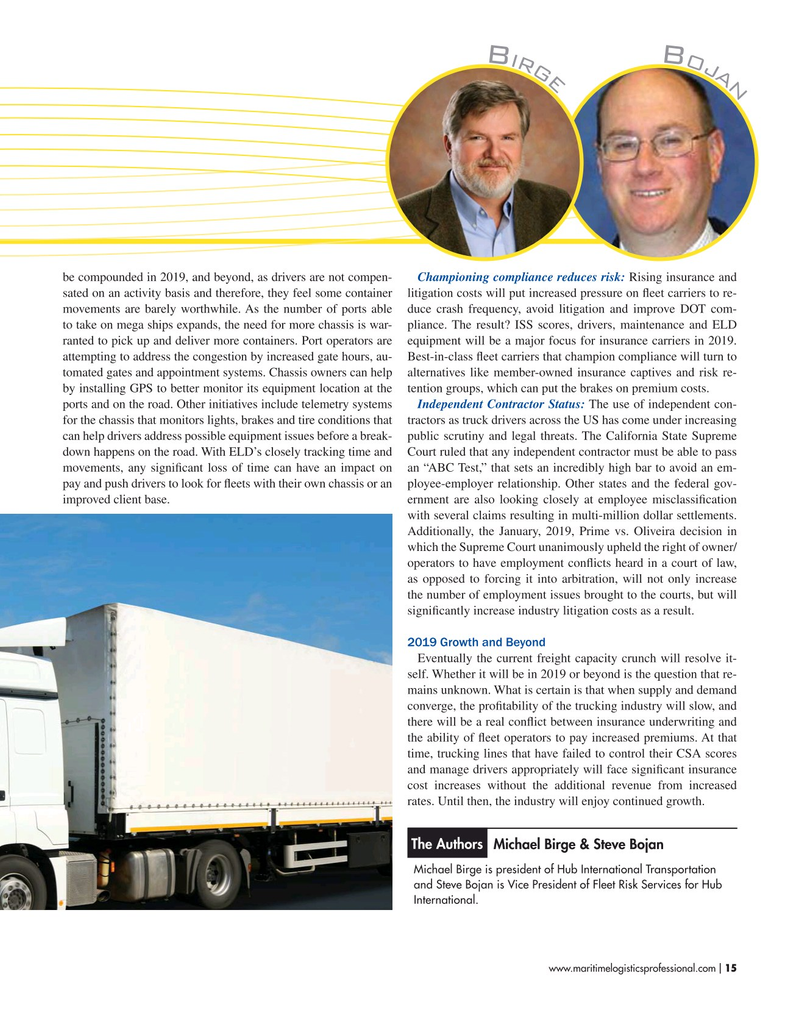
Page 15: of Maritime Logistics Professional Magazine (Mar/Apr 2019)
Container Ports
Read this page in Pdf, Flash or Html5 edition of Mar/Apr 2019 Maritime Logistics Professional Magazine
B
B
O
I
R
J
G
A
E
N be compounded in 2019, and beyond, as drivers are not compen- Championing compliance reduces risk: Rising insurance and sated on an activity basis and therefore, they feel some container litigation costs will put increased pressure on ?eet carriers to re- movements are barely worthwhile. As the number of ports able duce crash frequency, avoid litigation and improve DOT com- to take on mega ships expands, the need for more chassis is war- pliance. The result? ISS scores, drivers, maintenance and ELD ranted to pick up and deliver more containers. Port operators are equipment will be a major focus for insurance carriers in 2019. attempting to address the congestion by increased gate hours, au- Best-in-class ?eet carriers that champion compliance will turn to tomated gates and appointment systems. Chassis owners can help alternatives like member-owned insurance captives and risk re- by installing GPS to better monitor its equipment location at the tention groups, which can put the brakes on premium costs.
ports and on the road. Other initiatives include telemetry systems Independent Contractor Status: The use of independent con- for the chassis that monitors lights, brakes and tire conditions that tractors as truck drivers across the US has come under increasing can help drivers address possible equipment issues before a break- public scrutiny and legal threats. The California State Supreme down happens on the road. With ELD’s closely tracking time and Court ruled that any independent contractor must be able to pass movements, any signi?cant loss of time can have an impact on an “ABC Test,” that sets an incredibly high bar to avoid an em- pay and push drivers to look for ?eets with their own chassis or an ployee-employer relationship. Other states and the federal gov- improved client base. ernment are also looking closely at employee misclassi?cation with several claims resulting in multi-million dollar settlements.
Additionally, the January, 2019, Prime vs. Oliveira decision in which the Supreme Court unanimously upheld the right of owner/ operators to have employment con?icts heard in a court of law, as opposed to forcing it into arbitration, will not only increase the number of employment issues brought to the courts, but will signi?cantly increase industry litigation costs as a result.
2019 Growth and Beyond
Eventually the current freight capacity crunch will resolve it- self. Whether it will be in 2019 or beyond is the question that re- mains unknown. What is certain is that when supply and demand converge, the pro?tability of the trucking industry will slow, and there will be a real con?ict between insurance underwriting and the ability of ?eet operators to pay increased premiums. At that time, trucking lines that have failed to control their CSA scores and manage drivers appropriately will face signi?cant insurance cost increases without the additional revenue from increased rates. Until then, the industry will enjoy continued growth.
The Authors Michael Birge & Steve Bojan
Michael Birge is president of Hub International Transportation and Steve Bojan is Vice President of Fleet Risk Services for Hub
International. www.maritimelogisticsprofessional.com 15
I

 14
14

 16
16
